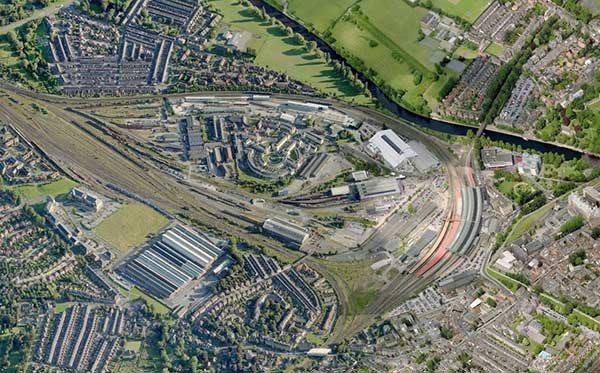
 As the council fires the starting gun on plans to develop the York Central site, Pete Wise offers a concise guide to its industrial past, derelict present and planned future
As the council fires the starting gun on plans to develop the York Central site, Pete Wise offers a concise guide to its industrial past, derelict present and planned future
It’s an area that has lain largely dormant for a generation. Since the Holgate Road Carriageworks ceased to buzz with industry and fell silent in the mid nineties, the ‘teardrop’ of land behind the railway station has become little-used, sparsely peopled and overgrown with weeds.
Old engine sheds, boiler rooms and foundries have decayed, with the only pistons in motion driving trains along a short stretch of track for the amusement of visitors to the National Railway Museum on Leeman Road.
What’s the history of the site?
Here in the dead space between Holgate to the south and east, Clifton to the north and York Railway Station to the west, is a fascinating cocktail of historic past, contentious present and glittering projected future.
The shape of its perimeter scored out with train tracks, the site now dubbed York Central once lay at the core of York’s railway industry.
Rolling stock was repaired, refurbished and assembled from scratch here by skilled railwaymen from the 19th Century right up until the 1990s. Having fallen by degrees into disuse and disrepair, the site is now earmarked as a key re-development project in the context of City of York Council’s plans to change the face and shape of the city through the construction of 20,000 new homes.
Why has the site remained derelict for so long?
Plans for the re-development of York Central have been under discussion for well over a decade. After a string of failed funding bids in the early 2000s, the recession hit and hopes of a full-scale redevelopment on the site had to go on ice. One of the major challenges was finding the money required to construct proper access to the site.
Has the access problem been solved?
On Tuesday, December 3, the council agreed to “earmark” £10 million from the city’s economic infrastructure fund towards the construction of a bridge linking York Central with the A59.
If all goes to plan, a deal would see the council take control of Network Rail owned-land to allow the bridge to be built. In return, Network Rail would get land next to Holgate Park.
The new bridge would remove a major obstacle to the redevelopment of the teardrop by providing access to the site for the immense fleet of construction vehicles and supplies which would be necessary to the project.
What is planned for the site?
Sprawling across a vast 91 acres (the Bar Walls circumscribe an area just under three times greater), York Central represents an unprecedented redevelopment in the very heart of the city.
Council leader James Alexander outlined initial plans for the teardrop whilst making a speech at York Business Conference on November 18, announcing the local authority’s intention to bring a “critical mass of Grade A office space”, shops, restaurants, a hotel and more than 1,000 homes to the site, with construction to commence in 2015.
City of York Council have pledged to build the new west York community in compliance with “urban eco-settlement standards” which promise to deliver sustainable housing to the “green credentials of eco-towns”. This means seeking sustainable sources of energy and water.
The pros and cons
In a city desperately in need of housing, to leave such a vast brownfield site undeveloped would be hard to justify.
Any disruption caused by such a major building project in the short term would be outweighed by the potential long-term social and economic benefits. The council predicts a £600 million annual boost to the local economy from the redevelopment.
On official projections York Central will create more than 8,000 full-time jobs and 6,700 construction roles.
But concerned residents and conservationists point out that there remains a lot of industrial history on the York Central site. Simply to demolish or ship out every last fragment of the remaining railway heritage would ill-suit a city which has previously proved so stubborn at hanging on to its man-made history.
Questions that remain to be answered
Council leader James Alexander told the York Press that the £10 million access bridge may not be permanent. There is no overall “masterplan” for the site, he added, preferring that the scheme adapts to prevailing market conditions.
